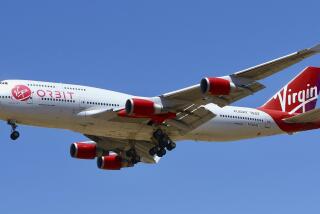Japanese Firm to Launch Hughes Satellites
- Share via
TOKYO — In a milestone for Japan’s space program, a private-sector rocket consortium announced Tuesday that it has signed a contract to launch at least 10 satellites for Los Angeles-based Hughes Space and Communications International Inc.
The deal marks Japan’s entry into the commercial satellite launch business, and is a sign that Hughes expects Japan to be successful in producing a reliable and relatively inexpensive rocket.
The launches of telecommunications and broadcasting satellites are planned for a five-year period starting in 2000, according to a statement by Rocket Systems Corp., a private company jointly owned by 73 leading Japanese firms.
If Hughes exercises its options for an undisclosed number of additional launches, “the deal would be over $1 billion,” Hughes spokeswoman Fran Slimmer said.
The launches will use the H-IIA rocket, a successor to Japan’s existing H-II rocket. The H-II is recognized as a world-class launch vehicle, but it is about twice as expensive as other countries’ rockets generally used for commercial satellite launches.
The H-IIA, currently being developed by Japan’s national space agency, is expected to be about half as expensive.
“We are honored to sign our first big contract with Hughes Space and Communications International as it represents the start of a new era for Japan’s space business,” consortium President Takaaki Yamada said at a signing ceremony in Los Angeles.
Donald L. Cromer, chairman of Hughes Space and Communications International, a unit of General Motors’ Hughes Electronics Corp., described the terms of the deal as “very competitive.”
Hughes has similar agreements with various rocket-launching firms around the world. Analysts say competition among those rocket makers is in Hughes’ best interest because it helps keeps launch costs under control.
“We want to be able to have a wide range of rocket choices available over a period of time so when our customers have a satellite ready, they can launch it,” Slimmer said.
While Hughes and Rocket Systems Corp. did not disclose the number of options in the contract, Japanese space officials have previously said they expected such a contract with Hughes to call for about 10 definite launches with options on up to about 10 more.
The H-IIA will be capable of putting into geosynchronous orbit Hughes’ two largest satellite models, the HS 601 and HS 702, which weigh three to five tons at launch. Liftoff will be from Tanegashima Space Center in southern Japan.
The Japanese government is paying for the development costs of both the H-II and the H-IIA rockets--the key vehicles for Japan’s own space program--but manufacturing and marketing of the rockets is being handled by Rocket Systems Corp.
The leading roles in that firm are being taken by Mitsubishi Heavy Industries Ltd., Kawasaki Heavy Industries Ltd., NEC Corp., Nissan Motor Co. and Ishikawajima-Harima Heavy Industries Co. These are the firms with key roles in building the H-II rocket or the future H-IIA.
The H-II is a domestically designed 260-ton rocket developed at a cost of $2.5 billion and first launched in 1994. At $170 million per vehicle, the H-II is seen as putting too much financial burden on Japan’s space program, in addition to being too expensive to compete in the global commercial launch market.
The first test launch of the H-IIA is planned for 2000. Its development costs are projected at $600 million, with per-vehicle costs of about $77 million, according to Japanese officials.
The H-IIA rocket to be used for the Hughes launches “hasn’t flown yet,” Slimmer noted. “But obviously we have faith in it or we wouldn’t have signed the contract.”
More to Read
Inside the business of entertainment
The Wide Shot brings you news, analysis and insights on everything from streaming wars to production — and what it all means for the future.
You may occasionally receive promotional content from the Los Angeles Times.









